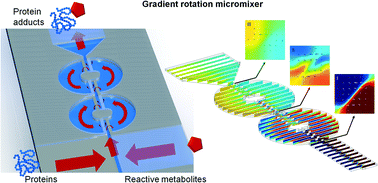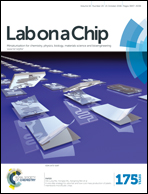Oxidation and adduct formation of xenobiotics in a microfluidic electrochemical cell with boron doped diamond electrodes and an integrated passive gradient rotation mixer†
Abstract
Reactive xenobiotic metabolites and their adduct formation with biomolecules such as proteins are important to study as they can be detrimental to human health. Here, we present a microfluidic electrochemical cell with integrated micromixer to study phase I and phase II metabolism as well as protein adduct formation of xenobiotics in a purely instrumental approach. The newly developed microfluidic device enables both the generation of reactive metabolites through electrochemical oxidation and subsequent adduct formation with biomolecules in a chemical microreactor. This allows us to study the detoxification of reactive species with glutathione and to predict potential toxicity of xenobiotics as a result of protein modification. Efficient mixing in microfluidic systems is a slow process due to the typically laminar flow conditions in shallow channels. Therefore, a passive gradient rotation micromixer has been designed that is capable of mixing liquids efficiently in a 790 pL volume within tens of milliseconds. The mixing principle relies on turning the concentration gradient that is initially established by bringing together two streams of liquid, to take advantage of the short diffusion distances in the shallow microchannels of thin-layer flow cells. The mixer is located immediately downstream of the working electrode of an electrochemical cell with integrated boron doped diamond electrodes. In conjunction with mass spectrometry, the two microreactors integrated in a single device provide a powerful tool to study the metabolism and toxicity of xenobiotics, which was demonstrated by the investigation of the model compound 1-hydroxypyrene.



 Please wait while we load your content...
Please wait while we load your content...